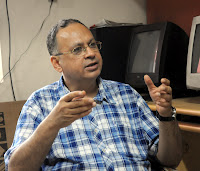‘Stagecraft’ has now become a synonym for English Theatre in Nagpur. But to reach to these heights, a lot was required from the group. And it poured a lot to turn theatre into a movement that is now finding ready acceptance among common theatre-lovers of Nagpur.
ENGLISH drama is not new to people of Nagpur. However, the following that it commands today is exceptional. Theatre-lovers get to see more than six plays a year — written, produced, directed and acted — all by Nagpur-based artistes.
In fact, with 250 enthusiastic people — young and old— attached with an English theatre group; hundreds of school children learning nuances of English theatre in regular workshops; and thousands of fans making the show of each play capacity-packed, English Theatre has neatly crafted its way into hearts of Nagpurians like never before. ‘Stagecraft Theatre’ can solely claim the credit of bringing English drama so near, and making it so dear to the city.
Established formally in 2003, the theatre movement finds its roots way back in 70s and 80s. Theatre Guru Vikash Khurana, founder president of ‘Stagecraft’ reveals an interesting journey of English theatre activity in Nagpur. “English Theatre exists in Nagpur since decades. While I was a primary students of SFS Boys’ School, I remember playing Cinderella, Snow White and other female characters in school plays,” recalls Khurana.
Inter-school drama contests, Tata School Trophy, Jaycees Drama Festival, and many other festivals used to see English plays being staged by school teams. However, the activity was restricted only to convent school auditoriums. It was Vikash Khurana, who brought it out from the school’s cocoon and made it big.
“After I returned to Nagpur from Mumbai after completing my graduation in commerce and having a small but very effective stint with Satyadev Dubey’s theatre group; I was eager to start some theatre activity in Nagpur.” Khurana recalls days of 1980s, “we used to stage one play annually at SFS Auditorium. The show used to be for select audience and we continued doing it for many years,” Khurana recalls.
 |
| Vikash Khurana |
After trying names like ‘Theatre Group’, ‘Theatre Unit’, ‘Players’, etc (in fact, a new name for every production), Khurana, finally, settled down with ‘Stagecraft Theatre’ in 2003. “New auditorium at St Charles Seminary opened with ‘Stagecraft’s first production ‘My Fair Lady’,” informed Khurana, his beaming smile implying that there has been no looking back.
One after another, ‘Stagecraft’ kept producing fantastic plays. In 2006, a simplified form of ‘Romeo and Juliet’ became an instant hit making the group a talk of the town.
“We realised that people preferred entertainment; but only entertainment is not enough. Quality, message, and value for money are all necessary. Nagpur took a little time to welcome English drama, but, when it did open its arms, it did so wholeheartedly,” says Khurana.
Today, ‘Stagecraft’ is a full-time institution. It produces plays round the year promoting young actors with each production. It also holds workshops for youngsters. “We only demand time and inclination from acting enthusiasts. Training of English and acting is our responsibility”, says the Guru, who is all ready to educate young artistes.
The recent ‘Summer Fiesta’ of ‘Stagecraft’ was a grand success where theatre groups of Marathi languages too joined hands. “English is our first love. But, we want entire theatre activity in Nagpur to grow. We never restricted ourselves to any particular language. We are ready to produce plays in all languages. The only emphasize being quality,” says Khurana. So while Stagecraft is entertaining people with various productions from old classics to new drama catering to all genre of the art, in process, also educating the audience, theatre lovers of Nagpur have lot to look forward to.








